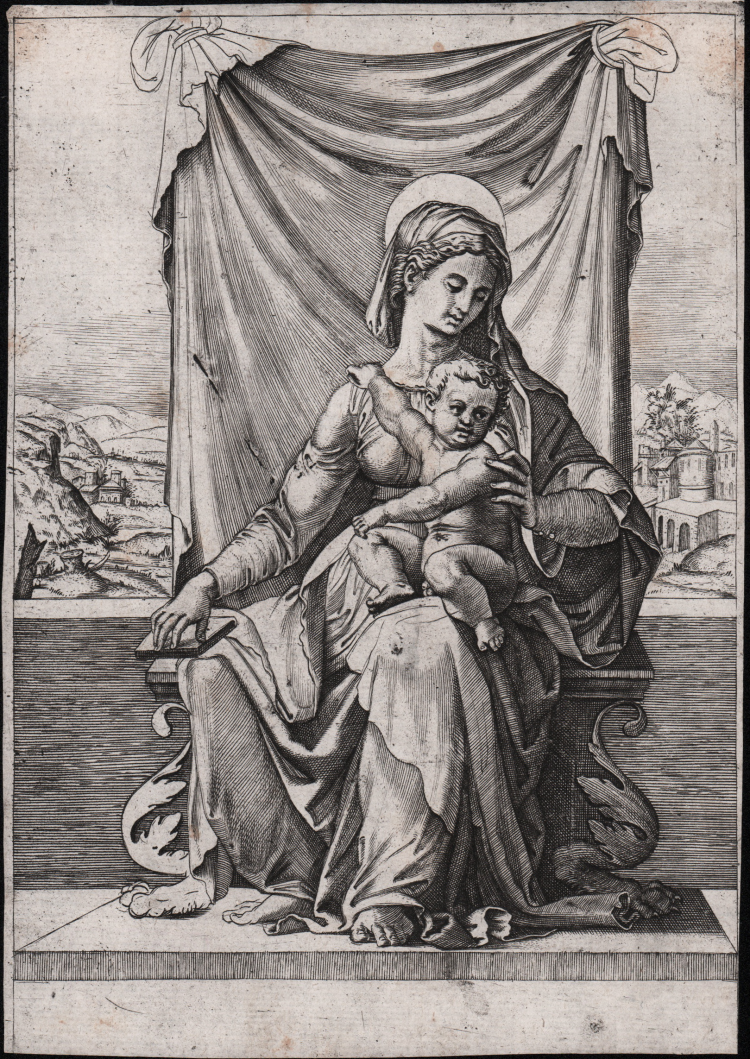




| Reference: | S30493 |
| Author | Scuola di Marcantonio Raimondi |
| Year: | 1520 ca. |
| Measures: | 135 x 192 mm |



| Reference: | S30493 |
| Author | Scuola di Marcantonio Raimondi |
| Year: | 1520 ca. |
| Measures: | 135 x 192 mm |
Engraving, 1520 circa, without date and signature. After Jacopo de’ Barbari.
A very good impression, printed on contemporary laid paper with watermark of “unicorn”, trimmed close to platemark, occasional foxing, generally in very good condition.
A very rare work, unknown to the repertoires and not present in the main collections.
In the British Museum collections we’ve found a copy, signed with monogram 'NWM' of the German printmaker Nikolaus Wilborn, engraver after the Little Masters and Jacopo de’ Barberi. His print, museum number 1845,0825.363, supporting the suggestion that the model is a work by Jacopo de 'Barberi.
According with curator’s comment of the British Museum, the Virgin resembles that in Hind 5, the Child that in Hind 3.
In addition, the crosshatching of the pedestal with the throne, and to the wall behind the group of the Virgin and Child is very similar to that one of The Adoration of the Magi, Hind 1.
The engraving style appears mature and accurately detailed. The elegance of the figures, the drapery of the garments undoubtedly refer to the Italian school, in particular to the school of Marcantonio Raimondi.
The collector's mark of Luciana Simonetti (Lugt 3616), on the back, who was an important collector of Sixteenth century Italian engravings supports our consideration.
|
Non descritta.
|
Scuola di Marcantonio Raimondi
|
Marcantonio Raimondi is considered the greatest engraver of early Renaissance and the first to spread the work of Raphael. He was born in San’Andrea in Argine, near Bologna. His first artistic apprenticeship took place in Bologna, around 1504, in the workshop of Francesco Francia, painter and goldsmith.
His first known engraving is dated 1505. In 1506 he went to Venice to live and work; in this year, he started developing his own personal style for, in his production that period, is quite evident the influence of Mantegna and Dürer. According to Vasari, Raimondi met Dürer in Venice, for they were both living there at the same time, but they had a quarrel over the reproductions, on copper, of Dürer’s seventeen woodcuts of the Vita della Vergine. After 1507, he turned to different models, especially those coming from Rome and Florence. He was in Rome in 1509, where he was introduced into the circle of the most important artists working in the City, such as Jacopo Rimanda from Bologna. In the same year he met Rapahel in the workshop of Baviera; the following year Raimondi became popular as the main interpreter of Raphael’s paintings. The Lucrezia can be considered the starting point of their cooperation and a sort of second beginning for Raimondi’s new style. In any case, together with the engravings representing Raphael’s works, Raimondi went on with the publication of his own subjects, especially antiquity, whose influence can be seen in his whole production (cfr. Dubois-Reymond 1978).
Between 1515-1516 Marcantonio started showing a keen interest for chiaroscuro, maybe under the influence fo Agostino Veneziano and Marco Dente, from Baviera’s workshop.
Till Raphael’s death, in 1520, Raimondi worked and lived in the background of the great artist from Urbino and engraved his works and those of his scholars.
His business went down after the Sacco (sack) Di Roma in 1527, when he was obliged to pay a huge amount of money to the invaders of the City to save his life.
He died in Bologna before 1534, in complete misery.
|
|
Non descritta.
|
Scuola di Marcantonio Raimondi
|
Marcantonio Raimondi is considered the greatest engraver of early Renaissance and the first to spread the work of Raphael. He was born in San’Andrea in Argine, near Bologna. His first artistic apprenticeship took place in Bologna, around 1504, in the workshop of Francesco Francia, painter and goldsmith.
His first known engraving is dated 1505. In 1506 he went to Venice to live and work; in this year, he started developing his own personal style for, in his production that period, is quite evident the influence of Mantegna and Dürer. According to Vasari, Raimondi met Dürer in Venice, for they were both living there at the same time, but they had a quarrel over the reproductions, on copper, of Dürer’s seventeen woodcuts of the Vita della Vergine. After 1507, he turned to different models, especially those coming from Rome and Florence. He was in Rome in 1509, where he was introduced into the circle of the most important artists working in the City, such as Jacopo Rimanda from Bologna. In the same year he met Rapahel in the workshop of Baviera; the following year Raimondi became popular as the main interpreter of Raphael’s paintings. The Lucrezia can be considered the starting point of their cooperation and a sort of second beginning for Raimondi’s new style. In any case, together with the engravings representing Raphael’s works, Raimondi went on with the publication of his own subjects, especially antiquity, whose influence can be seen in his whole production (cfr. Dubois-Reymond 1978).
Between 1515-1516 Marcantonio started showing a keen interest for chiaroscuro, maybe under the influence fo Agostino Veneziano and Marco Dente, from Baviera’s workshop.
Till Raphael’s death, in 1520, Raimondi worked and lived in the background of the great artist from Urbino and engraved his works and those of his scholars.
His business went down after the Sacco (sack) Di Roma in 1527, when he was obliged to pay a huge amount of money to the invaders of the City to save his life.
He died in Bologna before 1534, in complete misery.
|